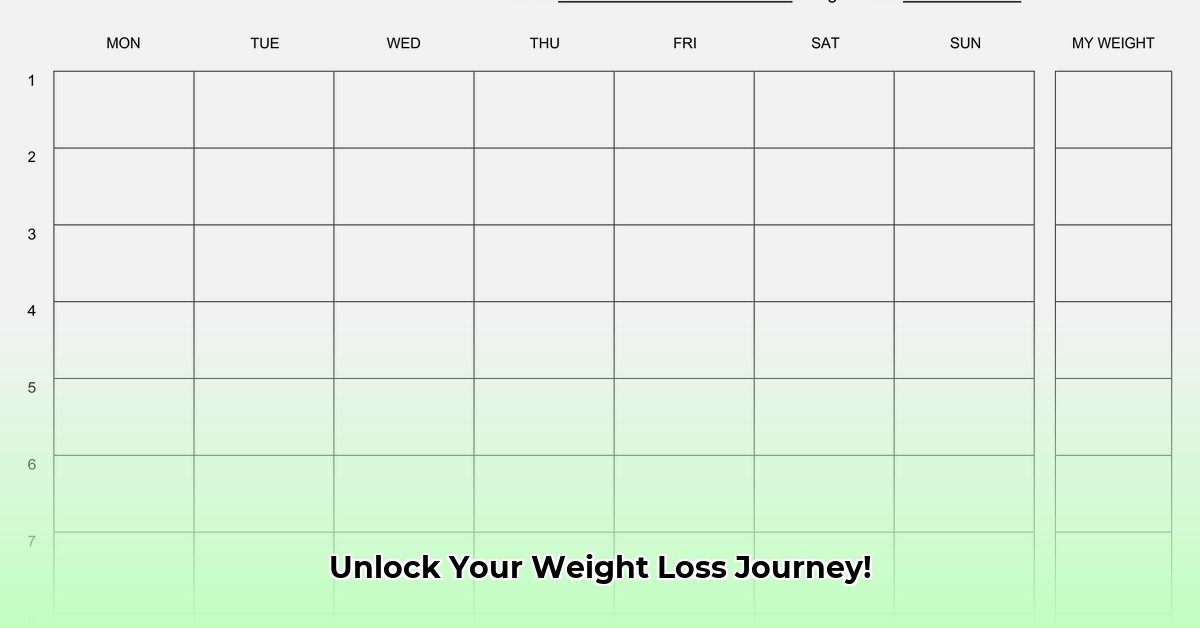
Weight loss can feel overwhelming, but what if you had a simple, visual tool to keep you motivated and on track? Downloadable weight loss charts offer just that – a tangible way to monitor your progress and celebrate your successes. This article explores how to effectively use these charts as part of a comprehensive weight loss strategy.
Weight Loss Charts: Your Personal Progress Roadmap
Printable weight loss trackers provide a powerful visual representation of your journey. Seeing your progress unfold can be incredibly motivating, transforming the often-abstract process of weight loss into a tangible, rewarding experience. However, it's crucial to understand that these charts are tools, not magic solutions. Their effectiveness hinges on their integration into a broader, holistic approach to weight management. Are you ready to unlock the potential of visual progress tracking?
Unlocking the Power of Visual Motivation
Many find that tracking their progress visually significantly boosts motivation. The act of physically marking your achievements, whether it’s a pound lost or a healthy meal logged, provides a sense of accomplishment and encourages continued effort. This visual reinforcement can be especially helpful during challenging moments, reminding you of how far you’ve come and inspiring you to keep going. But how does this translate into real results?
Making the Most of Your Weight Loss Tracker: A Practical Guide
To maximize the benefits of a printable weight loss chart, follow these steps:
Choose the Right Chart: Numerous free, printable weight loss trackers are available online. Select a chart that suits your needs and preferences. Do you prefer a simple line graph tracking weight loss or a more detailed chart that includes food intake, exercise, and mood? The key is to choose a chart you'll enjoy using consistently.
Maintain Consistency: Regular updates are critical. Aim for daily entries, even if it's just for a few minutes. Consistency builds the habit and provides the most accurate reflection of your progress. Think of it as a brief moment of self-reflection and accountability.
Set Realistic Goals: Focus on small, achievable goals rather than drastic changes. Setting realistic targets prevents discouragement and fosters sustainable habits. For example, aim to lose 1-2 pounds per week instead of aiming for a dramatic 10-pound loss. Small victories build momentum.
Comprehensive Tracking: Don't limit yourself to just weight. Track your food intake (including portion sizes), exercise (type and duration), water consumption, and even your mood and energy levels. A holistic approach provides a richer understanding of your progress.
Regular Review and Analysis: Regularly review your tracked data to identify patterns and trends. Notice any correlations between your food choices, activity levels, and your mood? This self-analysis helps you refine your approach and make necessary adjustments.
Embrace Setbacks: Weight loss isn't linear. Expect fluctuations. Use setbacks as learning opportunities; they don't negate your overall progress. Analyze what contributed to the setback and adjust your plan accordingly.
Essential Elements for Effective Weight Tracking
To gain the maximum insights, your chart should include:
Weight: Record your weight at the same time each day (e.g., first thing in the morning) for consistent measurements.
Food Intake: Track what you eat, focusing on portion sizes and calorie counts. This promotes mindful eating and awareness of your consumption habits.
Exercise: Record the types of exercise and their duration. This helps monitor your activity levels and aids in identifying exercise routines that are most effective for you.
Water Intake: Adequate hydration is essential for overall health. Track your water intake to ensure adequate hydration throughout the day.
Measurements (Optional): Track body measurements (waist, hips, etc.) to monitor changes even if the scale doesn't immediately reflect weight loss.
Mood and Energy Levels (Optional): Include these to provide a holistic perspective on your wellbeing and identify potential connections between your diet, exercise, and emotional state.
A Balanced Perspective: Weighing the Pros and Cons
While printable weight loss charts offer many advantages, it's important to acknowledge their limitations:
| Pros | Cons |
|---|---|
| Affordable and Accessible: Free and readily available. | Requires Self-Discipline: Success relies on consistent effort. |
| Visual Motivation: Offers a powerful visual representation of progress. | Limited Accountability: Lacks external support or pressure. |
| Highly Customizable: Tailor your tracking to your specific needs. | Not a Standalone Solution: Requires integration with a broader weight loss plan. |
| Promotes Self-Awareness: Increases awareness of food intake and activity levels. | May Not be Suitable for Everyone: Some individuals may find tracking overwhelming. |
Integrating Printable Trackers into a Holistic Weight Loss Plan
While printable weight loss charts are a valuable tool, remember that they are most effective when used in conjunction with a comprehensive weight loss plan that includes healthy eating, regular exercise, and mindful lifestyle changes. Dr. Emily Carter, a registered dietitian at the University of California, San Francisco, emphasizes, "Printable trackers provide a visual representation of progress, but sustained weight loss requires a holistic approach encompassing a balanced diet and consistent exercise."
Key Takeaways:
- Printable weight loss trackers are most effective when used as part of a comprehensive weight loss strategy.
- Visual tracking aids motivation and promotes consistency.
- They offer a customizable, low-tech alternative to digital tracking methods.
- Success requires a multi-faceted approach incorporating healthy eating, exercise, and mindful lifestyle changes.
Your weight loss journey is unique. Embrace the process, celebrate your achievements and remember that consistency, not perfection, is key. Use your printable weight loss chart as a tool to empower you on your path to a healthier, happier you.